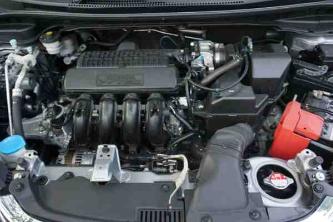fuel hose clip
fuel hose clip Related Articles

Woman driving Honda Civic against traffic in Johor arrested
was made after the Traffic Enforcement and Investigation Department (JSPT) was alerted of the video clip
15 - 21 April Fuel Price Update: No changes in fuel prices this week
This week, theres no changes in fuel prices.The fuel prices from 15 - 21 April 2021 will be as follows
This is why Ford is making artificial bird poop
poop but not completely resistant to it, so be sure to wash it off the moment you have access to a hose
Owner Review: Proton needs to upgrade their after-sales service - My 2020 Proton X70 1.8TGDI Premium
but it should behave better readings of fuel consumption like other competitors.
Used car buying guide: ZC21 Suzuki Swift – Which variant to get, what to look out for
One such hose is the hose for the rear windshield washer, as the rubber hose and plastic joints can get
What’s the Proton X50’s tested fuel consumption?
Proton claims the X50 returns a fuel consumption figure of 6.4-litre/100 km for the range-topping 1.5
Save money and drive safe with these three tyre care tips
It’s just a matter of ‘hose, meet tyre’ and you can do all four sides in a minute.This
6 little things we like about our Ativa – long term review #7
part you need in place.So, I had look underneath the Ativa to see what sort of clip was used to hold
See the interior of the 2021 W223 Mercedes-Benz S-Class in action
far fewer physical buttons than before.We don’t get to see much beyond that in this brief video clip
Perodua issues fuel pump recalls for 2018/2019 Perodua Myvi
Looks like the Perodua Myvi is affected by the global fuel pump issues as well.
2020 Proton X70 CKD fuel consumption test, 7.6L/100km possible?
Then the Proton X70’s 60-litre fuel tank was brimmed.Driving behaviour was as per a normal driver
6-12 February Fuel Price Update: Petrol, diesel up
Fuel prices see a 3 sen increase for petrol and 4 sen increase for diesel.The fuel prices for the upcoming
How fuel efficient is the Toyota Vios?
Toyota claimed improved fuel consumption compared to the previous powertrain, but by how much?
New Honda Civic Type R to set new lap record at Suzuka
The 15-second clip shows the Limited Edition CTR being unloaded, prepped for track work, and pounding
2020 Toyota Hilux facelift previewed, sooner-than-expected Malaysian launch?
The short 10-second clip shows the Hilux hiding away in the shadows as it’s H insignia shows different
How fuel efficient is the 2020 Perodua Bezza?
We already know the Bezza is well know for its fuel efficiency but there werent any official real world
13 - 19 May 2021 Fuel Price Update: Fuel prices remain!
Another week and its time for the weekly fuel price update.
Ratings: Nissan X-Trail 2.0L fuel consumption, slightly above average score
Nissan claims that the rated fuel consumption for the Nissan X-Trail 2.0L is 13.4km/litre, which translates
15 - 21 August 2020 Fuel Price Update: Price increase for all fuel types
It was nice while it lasted, but now the inevitable has happened: both petrol and diesel fuel prices
Owner Review: A not so reliable Toyota - Story of my Toyota Celica
Superb handling & safety attributes (to own liking, not to be compared with other cars) Decent fuel
fuel hose clip Post Review
.@RenaultIndia recalls 50,000 units of #Kwid over faulty fuel system, hose clip https://t.co/l3HjZAR8iZ https://t.co/7UDNuyBFkY
#Renault recalls 50,000 #Kwid in India to rectify faulty fuel system and add hose clip. https://t.co/ZHU7md4krC
FITS FUEL LINE HOSE PLASTIC CLIP 06-11 KIA RIO OEM https://t.co/ZkfJoSU04D https://t.co/MwsT7ViOdq
MINI Cooper (2011-2012) Fuel Hose with Clip-Inlet to High Pressure Fuel Pump https://t.co/tuKUi1EgGM eBay https://t.co/iUaEF4itHC
http://t.co/qo8ya5A1Bt #10: Replacement 3/8" Fuel Gas Line Hose Clamps Tube Clip Replacement 3/8" Fuel Gas Lin... http://t.co/MSw1TUdgQg
x TRIUMPH 500 650 OIL FUEL TANK HOSE LINE FILTER CLIP CLAMP 4 EA... 9/16" ID NEW https://t.co/vJAJ7Y4px0 https://t.co/qKO0MEvHOM
Ambling around a cloud-bound Mora la Nova while I wait for the hardware shop to open. You wouldn’t believe how hard it is to buy a 6mm double wire spring fuel hose clip in Southern Catalunya... 🤷🏻♂️🇪🇸 #DailyLife https://t.co/L5JfWj4PqO
Found why Elly started leaking fuel when I filled her up last night. Hose clip has rotted itself apart! #2CVtoCroatia https://t.co/i6A6qE9tPv
new fuel filter fitted, with a new fuel hose clip as well http://t.co/YV0wl3hq
http://t.co/VZKEaRCBCY Fuel Rail Hose Clip - Torque Increased Jaguar XJ-S V12-5.3L (1982)
fuel hose clip Q&A Review
Do Diesel cars require daily running?
Well this is a really good question but you know what, a big yes would have been my answer if it was asked a couple of decades ago. But now a big NO. There were two frequent problems which people face with a diesel car Cold start: ,As you know earlier, the cylinder s were wrapped with a coil to warm up, for say around 15 mins, before we take a ride, or, even the fuel was to be heated, but still there were frequent problems of cold start as they were all indirect injection engines or very rarely unit injection engines. But from 1996, after the legendary automobile manufacturer Fiat Chrysler developed CRDI engines the fuel pressure at injection was so high (almost 2000 bar nowadays) and so was the atomisation, which will make the fuel always “ ready to burn”. Air entrainment: ,This is a problem which we still face in many cars. As the cars age, the fuel lines are prone to air entrainment which will cause the vehicle immobile. This mainly occurs if you keep the car undriven for some 10to 15 days, depending upon the line. But all these cars are equipped with 2 kickers, one next to throttle, the other next to fuel filter. These are used to remove air from the lines. What all you have to do is just squeeze them for a couple of times, and you can run your vehicle smoothly again. If the frequency of this trouble is less than 10 days you have to tighten the hose clips or change the fuel filter(normally once for every 30k kms) But the latest cars have very rigid steel line and this will solve the problem. So at the end, these days, diesel cars can be driven without a single issue.
How long would it take to fall from an airplane?
Most people don’t fall from an airplane, however, I have. Back when I was doing my Private licence back in 2003, the Primary aircraft in my logbook was a Cessna C172M VH-MHG. We would park MHG on the grass/dust/mud parking area near one of the taxiways at Bankstown Airport. Traditionally we would request a fuel truck to come and fill the plane up, and the fuel driver would come to the plane with fuel, set up a ladder and static lines, and then go up and fill the tanks up from the truck. One day, we flew to a small airfield, and needed some fuel to come back to Sydney. There’s no fuel service truck at this town’s airport. Instead, there was a fuel bowser situated near the general aviation parking area. We had to taxi over to it, shut down the aircraft and then clip the static line into the grounding peg, Chock the wheels, and then swipe a credit card into the fuel bowser to let it start pumping. The credit card would be charged once the fuel hose was placed back in to the cradle which would also lock the hose in place. When the credit card was swiped and pin code entered, the fuel pump would start, loudly, with its electric pump, and pulling the trigger on the hose nossle would let fuel come out. We did not carry a ladder with us on board the Cessna, so the nearest ladder we knew about was probably either sitting at Bankstown, or in a hardware store somewhere in the nearby town. But there were some footholds placed on the Cessna so you could stand up high enough to do the preflight checks, which include checking the fuel tank levels with a dip stick, and ensuring the caps were closed. So it should have been easy enough to pull the hose up to the wing while standing on the footholds and then pump some fuel into each tank. …. it was not easy. I didn’t break any bones, but I did rough up the hose nozzle pretty bad, and twisted by back and hips pretty bad too. Tying the aircraft down at the end of the flight was a new and exciting experience in pain and learning how to avoid bending directly straight over to tie rope around a little peg in the ground. Also, the Cessna C172’s wing is about 5ft11in off the ground. My head is about 6ft1in above the ground. The scar healed in about 6 weeks.
How do you go about changing a fuel filter for an older carbureted engine?
Depends on the model of carburetor … and whether it’s been modified at all. Many American carburetors — like many from GM’s Rochester division, or from Holley, Carter (or later Edelbrock) — have a sintered bronze filter in the fuel inlet. To change that, you need to remove the fuel line from the carburetor, then the filter will either drop out or you can simply pluck it out, and reverse the process to install a new one. But the sintered bronze filters are quite restrictive — especially when they start to get dirty, which can significantly affect fuel flow, which causes performance issues. So, it was common practice to remove the sintered bronze filter and replace it with an inline canister-style filter (often with a clear housing, to allow quick inspection of flow and the filter’s condition). Such inline filters are usually spliced into the hard fuel line between the fuel pump and the carburetor(s), using two short sections of flexible, rubber fuel hose and four clamps. To replace such a filter, loosen the two clamps at the inlet and outlet of the filter, detach the rubber fuel hoses from the filter, and reverse the process to install a new filter. Some vehicles have cartridge-style fuel filters: usually a cylindrical paper element contained within a removable steel housing. To replace such a filter, remove the steel housing (usually by unscrewing or prying off the retaining clip), and replace the filter element, the reinstall the housing cover and clip. It’s worth noting that most fuel tanks also feature a “sock-type” fuel filter on the inlet end of the sending unit. These aren’t usually replaced as routine maintenance, but are definitely worth replacing if the vehicle has been sitting for a long time or there’s reason to believe that the inside of the tank might be dirty or rusty, as the sock might be clogged or damaged.
How long does the jet fuel supply on a US Navy supercarrier last for its carrier air wing of approximately 75 aircraft?
Really, not very long. But, a carrier never operates alone. It is in what is called a task force. Part of that task force id the 'oilers'. These fuel ships carry not just jet fuel, but gasoline and diesel fuel for the other equipment on the carrier, like the crash/fire trucks, etc. They also refuel the rest of the ships in the group. It's a very tricky thing, but as we sail along at a reasonable clip, the oiler comes up alongside, and we shoot lines over to them. They grab the lines and pull them in. They then attach the lines to the fuel hoses, and pull them over to the carrier where we plug them into the side of the ship and start taking on fuel. Quite often, another ship in the group will pull up on the other side of the oiler, and take on fuel at the same time. This is also how we get new ordnance. The ammo ship pulls up alongside and we shoot the lines and rig it all up, and they send us pallets of bombs and whatever else we need, like groceries, supplies for the ship's stores, or whatever else we need. And, we transport the mail over to them. See, we normally get mail every day when the supply plane lands, and we transport it over to the supply ship, and when they resupply the other ships, they also send over the mail. An Underway replenishment (UnRep) is an amazing thing to watch. It's all Morse code and flag signals from one ship to the other, for the entire event. Very professional. And, while all that is happening, there are people below taking the ordnance and other supplies off the elevators and storing it all away.
Why can Ferrari not be driven daily?
A friend of mine bought a 1984 F308 GTS Quattrovalvole in 1988 with 11,000 miles on it. It was his daily drive until it reached 110,000 miles and was retired to ‘weekend’ status in around 1998. It was (mechanically) fuel injected and started on the first touch of the key every time. Apart from routine by the book servicing, the only ‘extra’ thing he did was to have a spare set of Koni shocks which were rebuilt and swapped over every 20,000 miles. The car was regularly red-lined and on one trip through Germany sat at 160 MPH for several minutes. At the yearly MOT check at 100,000 miles its emissions were still at the same level as when it was built. The only time it broke down was when emergency braking from 150 mph the engine moved forward on the mounts enough to pop a hose off, A set of Jubilee clips sorted that. It was significantly more reliable than his 550 Maranello which itself was a daily driver and racked up 120,000 before it was sold. This was in the UK where 8,000 a year is average mileage for a privately owned car…. So yes, you can use one as a daily driver, but the ‘by the book’ maintenance is NOT cheap….
What are the steps to winterize a boat for dry dock storage?
There are many things to be done & so many variations, depending on: Is the boat sailed in salt water or fresh water ? Is there a fixed engine ? Will the mast be lowered ? Will the boat be stored on a trailer ? Will there be shore power available ? Will there be snow ? Etc., etc. A basic list would include: 1. Remove weed/scum from hull & clean topsides & deck before the weed or dirt dries out. Even one hour of delay in removing weed or scum from the hull will create a lot of extra work. 2. Wash the salt from everything ! Sails, running rigging, clean the entire interior. Dried salt crystals destroy artificial fibers and obviously, salt attracts moisture. Pay attention to electronics. 3. Remove sails & running rigging, to avoid chafe in the winter winds. Inspect for wear & tear & replace/repair as necessary. 4. Winterise engine. Fill fuel tanks to prevent build-up of moisture. Winterise batteries as appropriate to their type. 5. Check sacrifical anodes and thru-hull fittings, hose clips, etc. 6. Remove cushions etc. To prevent them getting damp. 7. Don’t allow rope halyards to become weathered; either mouse with string or cover, etc. 8. Remove masthead instruments as appropriate. I prefer to unstep all masts, to prevent metal fatigue from doing its dirty work over the winter, but most folks don’t bother nowadays. If the mast is on the ground, it’s much easier to inspect fittings for wear, change bulbs & so on. 9. Cover wooden boats with appropriate ventilation. Cover boats located in an area of heavy snow. 10. Install a de-humidifier, possibly. Etc. ....... This is by no means a comprehensive list ! Check with sailors & boatyards in your area and owners of similar boats. The more work you do at the end of the season, the longer your boat & its equipment will work as you expect.
What was your craziest experience with weather?
I was in Antarctica 1972–73. Several of us had been tasked to transfer some fuel hoses from one sled to another before a storm was to hit around midnight. Leave it to the weather guessers to mess up. Around 9 p.m. ‘herby’ hit us HARD. All but 7 of us headed for the base. We 7 had finished loading the fuel hoses to the new sled, mounted the “ski cat” to make a run for the air field. Five of us were in the cat, one tied to the front bumper with a spot light, one on top with a spot light. The wind died just for a couple of seconds and the man on top started beating on the roof. We were headed at about a 90º angle from the air field….out onto the Ross Sea (frozen over). We got to the air field and found the chow hall. There we sat for 4 days while the wind and snow blew so hard we couldn’t see but a couple of feet. The head (bathroom) was in the building next door. We had a rope strung between both buildings. When we had to go over, we had a belt around us with a clip attached to the belt and rope. If someone was gone for more than 5 minutes, another person would have to go after them. Fortunately, no one took that long. We were down to a very small ration of food when the storm let up and we mounted the snow cat and went back to McMurdo.
What's the easiest way to replace the fuel pump on a 1993 Chevy S10 4.3L V6?
If I’m correct, this pump is an in-tank unit, located under the front of the truck bed. There are 2 ways you can go about this repair. The first involved a few friends and possibly some beer. This method will involve loosening the 4- bolts that hold the bed to the frame and lifting the front edge of the truck bed up enough to access the pump. Don’t forget to unhook filler neck from door. I reserve this method for tanks that are above 1/2 tank. The second involves simply dropping the tank. That should be: a couple of small screws holding the filler neck in place to the filler door and the 2- bolts securing the tank. This is easier when the tank has less fuel in it because I think those tanks are plastic. Use a floor jack with a block of wood or a spare sm piece of plywood to slowly lower the tank. Make sure you don’t damage fuel lines on the way down by unhooking them too. Word of advice: make absolutely sure the gauge works, if not replace. Also buy a new strainer sock to keep trash out of new pump and replace ALL short hoses, clips, o-rings, etc. and lubricate main o-ring before installing lock-ring. Good Luck!
How do I clean a fuel injector? What are the best methods and ways?
If the injector is removed from the car I have used the following method. Get an injector plug and wire it so be clipped to a 12v battery. Get a foot long section of fuel hose and clamp to fit the inlet on the injector. Fire up the compressor and put on an air nozzle preferably with a rubber tip. Mount the injector in a vise with soft jaws. With the fuel line clamped to the injector . spray the hose full of carb cleaner. Connect the plug to the injector and power it up . the injector should click to open , then apply air pressure to the end of the hose adjusted to fuel pressure level. this forces the cleaner through the injector. We had two injectors almost completely blocked on a Chevy LS engine that had been setting up for several years with bad fuel. It took three cycles of cleaning and both injectors were back to normal spray patterns. the injectors were reinstalled in the vehicle with fresh fuel and fuel cleaner additive in the tank . About a days worth of normal driving and the vehicle was back to normal operation.
How needed is a tune-up for older cars?
All vehicles require maintenance regardless of age. Regardless of vehicle age the necessity for routine Oil, and Filter change and brake maintenance has not altered. Neither has the necessity for a periodic visual underhood/bonnet check. Especially, checking for oil leaks, cooling system hoses and security of hose clips and engine drive belts and battery terminal security and cleanliness. Many late model vehicles have partially eliminated much maintenance that was periodically required on older cars eg.: Spark Plug replacement that was once recommended at 10,000 miles, has been substituted to between 100,000 km. & 160,000 km. replacement with the advent of Iridium spark plugs. Ignition Contact points: The periodic necessity to clean or replace is now obsolete. Ignition Spark Plug leads: now obsoleted with Coil on plug development. Cooling systems: that have 160,000 km long life pink coolant has reduced this maintenance considerably. Power Steering and fluid: Maintenance, Top ups, and potential leaks is now in the past with Electric Power Steering. Fuel Injection: This has obsoleted cleaning and adjustment of carburettors, and air leaks from distorted base mounting blocks and worn throttle shaft spindles. Unfortunately, it is not all good news currently with the multitude of engine sensors and electronics that can fail. Also with the progression to Direct Fuel Injection, there is now the periodic requirement to glean carbon deposits from inlet Valves and Manifolds. Re. Your question, How needed ? You as the owner driver should be better able to judge the age of your vehicle and whether it has, or has not, any of the aforementioned lesser maintenance systems or whether the performance of your car has deteriorated, better than speculators on a forum. That said, there is nothing to prevent someone without any technical knowledge to read the owners handbook, or aquire one, and attend to some of the simple recommendations. Even open the bonnet/hood and wipe around with a rag and clean around the battery and terminals. Take precautions with battery acid if present - it can be neutralized with baking soda and hot water.
 HOME
HOME 


